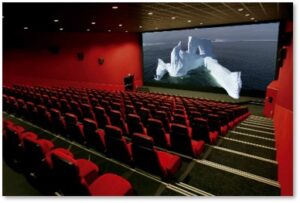The Covid-19 Pandemic changed a lot of activities that people once did routinely and took for granted. One of things that changed for us was going to the movies.
Walking to the Movies
My husband and I both love the movies. When we lived in Brooklyn, our apartment was within walking distance of five movie theaters, ranging from a small minimalist art house to an enormous, gilt-encrusted palace from the thirties. Taking in a movie was a nice way to get out on Saturday night without dropping the kind of money needed for a Broadway play, a Lincoln Center performance, or even a Mets game.
When we moved to Massachusetts, we found local theaters and continued to watch movies on the big screen nearly every week. We had different likes and dislikes so we alternated our selections, with one person picking a movie one week and the other choosing the next week. Eventually our likes (mostly) merged.
Closing the Theaters
Over the years, we saw a lot of films and ate a lot of popcorn—minus the fake “butter.” All that came to a screeching halt when the pandemic closed theaters and made everyone leery of sitting cheek-by-jowl with strangers in crowded places. Hollywood stopped making new movies, so we watched the offerings available on TV.
 TV was so important then that people traded suggestions and recommendations on what to watch. That’s why I began writing my Pandemic Watchlist blog posts.
TV was so important then that people traded suggestions and recommendations on what to watch. That’s why I began writing my Pandemic Watchlist blog posts.
Those strictures have eased up and movie theaters are attempting a big comeback with new—and in some cases long-delayed—movies to attract viewers. Is that enough to bring people back to the big screen? I have my doubts.
Three Big-Screen Recommendations
We have actually seen three movies in the theater since they reopened: A Quiet Place 2, No Time to Die (the new James Bond flick), and Dune. All three cried out for Big Screen treatment. We chose our days and times carefully to avoid crowds: A rainy Sunday afternoon for two, early Friday afternoon for a third.
 And it worked. When there are only four or six people in a theater, you don’t have to worry about social distancing. Still, it felt eerie to walk into an empty lobby where once people lined up for tickets and snacks. The popcorn machines didn’t pop non-stop to keep up with endless demand and the soda fountains weren’t churning out gallons of fizzy sugar water. It felt like a neutron bomb had gone off: the facilities remained untouched but there were no people.
And it worked. When there are only four or six people in a theater, you don’t have to worry about social distancing. Still, it felt eerie to walk into an empty lobby where once people lined up for tickets and snacks. The popcorn machines didn’t pop non-stop to keep up with endless demand and the soda fountains weren’t churning out gallons of fizzy sugar water. It felt like a neutron bomb had gone off: the facilities remained untouched but there were no people.
We were right about the Big Screen treatment. I recommend both No Time to Die and Dune and suggest that you find off-times to see them and avoid the crowds. (If you plan to see Dune, see it on the Big Screen. Really.)
Returning to Normal?
As the pandemic eases, and vaccinations increase, will my husband and I return to our normal movie-going habit? Probably not. We have become accustomed to watching series that are streaming and that provide a more in-depth approach to storytelling. There’s a lot to be said about giving a story the time and space to develop, actors to settle in to their roles, screenwriters to take their time, and cinematographers to make the most of their visual possibilities.
Would it have been better to watch News of the World on the big screen instead of our TV? Probably. It’s an excellent movie and the wide-open spaces of Texas cry out to escape the small box in our living room. But we still enjoyed it.
Luring Viewers Back to the Movies
So, what are theaters doing to lure viewers back to the movies? Not enough in my opinion. Employers have responded to the post-pandemic resignation surge and current hiring difficulties by raising wages, increasing benefits, encouraging work from home, and generally being nicer to employees.
 During the Great Depression, theaters kept people coming to the movies by getting creative and taking risks. They cut prices and ran double bills, gave away dishes and glassware, and ran a lottery called Bank Night. (Those Depression-glass dishes are worth a lot of money now.)
During the Great Depression, theaters kept people coming to the movies by getting creative and taking risks. They cut prices and ran double bills, gave away dishes and glassware, and ran a lottery called Bank Night. (Those Depression-glass dishes are worth a lot of money now.)
What are theaters doing now? Very little. We’ve seen a commercial on TV starring Nicole Kidman giving a low-intensity pitch on why it’s important to go to the theater. Our local Regal Cinema awards more points for attendance and free popcorn on Tuesdays. That’s about it.
Filling the Lobby Again
It’s not enough—not by a long shot. Attendance may rise over time but theaters need a big boost to jump-start attendance and get back to profitability.
In the most recent quarter, AMC Theaters reported sales of $144 million, a huge contrast with the $1.5 billion they recorded in the comparable, pre-pandemic period of 2019.
 Still, IMAX CEO Richard Gelford says “The movies are back.” I haven’t seen evidence of that. Even when we left the theater after watching Dune—a time when Friday-night viewers would formerly have thronged the theater—the lobby was empty.
Still, IMAX CEO Richard Gelford says “The movies are back.” I haven’t seen evidence of that. Even when we left the theater after watching Dune—a time when Friday-night viewers would formerly have thronged the theater—the lobby was empty.
And that’s here in Massachusetts, which has a low Covid positivity rate and the highest vaccination rate in the country. Mr. Gelford’s false optimism will not help either the industry or struggling theater owners.
The industry appears to be counting on that optimism, along with high-quality or long-anticipated movies, to bring people back in. Plus, the holiday season is approaching. That seems like a pretty weak response to me. None of the many trailers we watched before No Time to Die and Dune got a thumbs-up from us. Even in the Before Time, we wouldn’t have bought tickets to see them.
Depression-Era Creativity
How about some of that Depression-era creativity in the 21st century, folks?
Bring back double bills. Add cartoons. Offer give-away nights for something people like. Hand out gift cards or lottery tickets. Bundle movie tickets with restaurant discounts. I have lots of ideas.
But do something that will get viewers off their butts and back in the theater. Hope is not a strategy and business as usual will not help the movie industry recover, or improve quickly.

